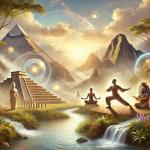Growing up in Miami, my first experience of racism was in the early 70’s in middle school when they began bussing in students from an all black school nearby. Riots were an everyday event, which I did my best to avoid, only once getting hit in the head with a flying object thrown down the stairwell while changing classes. Years later, while driving in a less populated area, I saw for the first time a Ku Klux Klan member in full regalia standing on a corner holding a sign announcing their next rally. A haunting chill went down my spine that day. This lingered in me as an undercurrent of unrest I would not fully understand until much later.
While a great deal of progress has been made over the past 50 years, it seems that many racial barriers and problems continue to plague our nation. The alarming number of recent fatal police encounters with young men of color have spurred racial tension across the nation.
I have dedicated almost three decades to studying, preserving and promoting West African music and dance. Through these experiences I’ve witnessed the community-building power of drum and dance, and watched firsthand as longstanding racial barriers and tensions dissolved.
One of the first steps, I feel, is to replace fear with respect and curiosity. Officers involved in police shootings have reported being afraid, fearing for their lives. Consequently, they may inflate the level of threat and act impulsively. What if they could feel something other than fear? What if, having had a direct hands-on experience of African culture in a drum or dance class led by a teacher of African descent, they could feel a new sense of kinship and community? What if African Drumming and Dance were a part of police academy training as well as taught in schools—especially those in the inner city? I believe this type of positive interaction could go a long way in quelling the fear, mistrust, and knee-jerk reactions between police and men of color.
Cultural barriers often melt away on the dance floor and in drum circles when people of various ethnicities and different ideologies are united by the universal language of music, dance and laughter. The power of drumming and dancing together creates a dialogue and a dynamic energy exchange that can shift old paradigms into a new frame of reference. The drum connects us instinctively to our heartbeat, the one thing we all have in common. A drum circle usually starts with everyone playing their own rhythm, often chaotically, and out of sync. Then magically people begin to synchronize and follow the beat—suddenly a group of strangers from different backgrounds is playing music together as a cohesive ensemble, and in the process they feel connected, empowered, and in harmony with each other. I have seen improved race relations within communities that come together regularly to share in this rich culture.
Events of the last few years and this latest tragedy in Charleston, the port of entry for thousands of African slaves, brings to the surface hundreds of years of unresolved grievances and shines a light on a chapter of American history that begs to be healed. Each of us has the power to participate in this healing and make a difference—in our daily thoughts, words, and actions.
A number of years ago I coined the phrase “Give Peace a Dance” to describe my work and passion teaching multi-cultural dance. Originally, the broad vision was to build bridges to connect cultures using music and dance. In response to recent events, a more focused version of this might be “Give Police a Chance”--a chance to be looked at as “Peace Officers.” To really bring about change we all have to be “Peace Officers” and it starts with one person having a change of heart, surrendering the old story for the new and improved. I believe we can all create positive change in our society . . . one dance step, one drum beat at a time.






